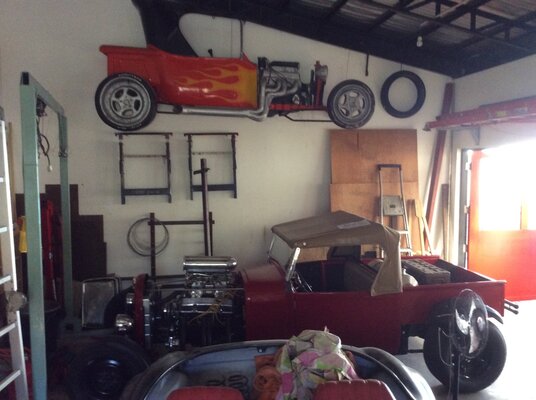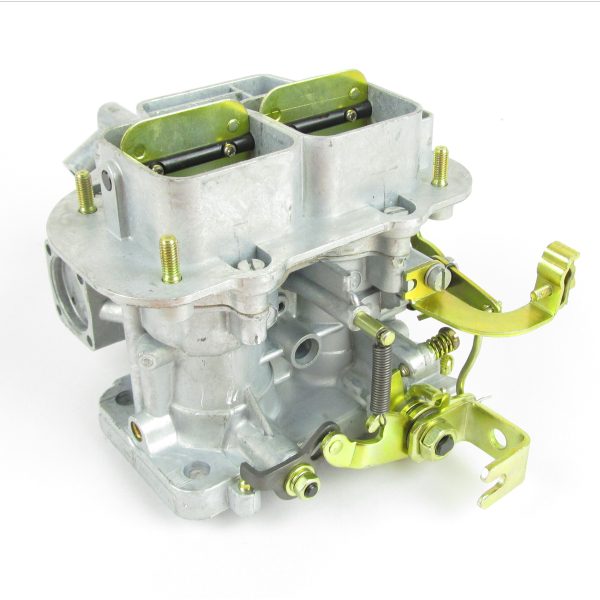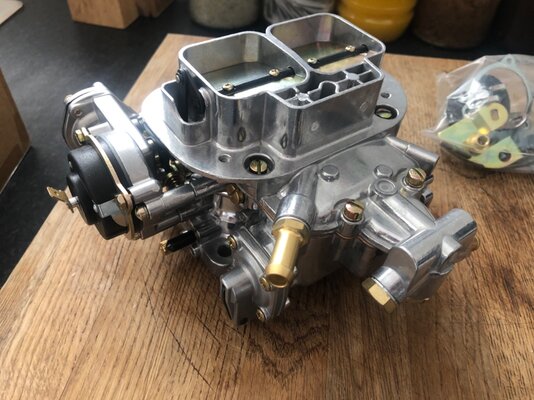You are using an out of date browser. It may not display this or other websites correctly.
You should upgrade or use an alternative browser.
You should upgrade or use an alternative browser.
Slightly obsessive Weber 32/36 tuning
- Thread starter RIP
- Start date
Morrisman
Forum Supporter
- Messages
- 9,074
- Location
- Staffordshire, England
When I put the twin four barrel tunnel ram on this everybody told me it wouldn’t run smooth, wouldn’t tick over below 2000, wouldn’t pull properly until 5k rpm etc. The carbs were 600 Holleys, with vacuum secondaries.One of the biggest problems with over carbing is the lack of velocity in the charge to keep fuel suspended/atomised. A mate of mine built up a mildly tuned 302 ford for his Cobra, all the advice given was to go with a 650 cfm four barrel double pumper, only ever ran properly when the link bar was removed on one set of butterflies, in effect turning it into a two barrel carb.
Bob
It idled at 700rpm, ran perfectly, would smoke the tyres simply by pushing the pedal down hard while burbling along at tickover etc.


Melvyn Best
Member
- Messages
- 1,938
- Location
- Cambridge
I managed to set up the fueling on my locost with a 1600 Xflow converted to full Emerald engine management pretty well so that I could get a few miles on the engine before the car went on the rolling road by driving the car at a steady speed and throttle opening while my brother adjusted the fueling on the laptop. It helped that the ECU has a built in gas analyser and throttle load/speed indicator. Dave Walker set it up for me and complemented me on the initial set upNot so sure you could ever get an accurate reading without holding a steady state engine load like on a dyno, touch the throttle and in goes a load of fuel from the accelerator pumps.
Bob
8ob
Member
- Messages
- 14,373
- Location
- Nescient in the vale
I managed to set up the fueling on my locost with a 1600 Xflow converted to full Emerald engine management pretty well so that I could get a few miles on the engine before the car went on the rolling road by driving the car at a steady speed and throttle opening while my brother adjusted the fueling on the laptop. It helped that the ECU has a built in gas analyser and throttle load/speed indicator. Dave Walker set it up for me and complemented me on the initial set up
I spent three days with with Dave on his rolling road mapping an engine with one of his ECU's, he knows his stuff or did do, I believe Carl runs the show know, they have come on a long way in the ECU world.
Bob
Melvyn Best
Member
- Messages
- 1,938
- Location
- Cambridge
He managed to set my car up pretty quickly fortunately, I would hate to have had to have paid for 3 days on the rolling roadI spent three days with with Dave on his rolling road mapping an engine with one of his ECU's, he knows his stuff or did do, I believe Carl runs the show know, they have come on a long way in the ECU world.
Bob
pedrobedro
Man at Matalan
- Messages
- 13,108
- Location
- CX near Chesterfield
A friend of mine fitted 1.5" SU carb to his SJ410. It took some experimenting with needles but it ran better than the knackered original carb.
8ob
Member
- Messages
- 14,373
- Location
- Nescient in the vale
He managed to set my car up pretty quickly fortunately, I would hate to have had to have paid for 3 days on the rolling road
Mostly my fault, day one we got it to 3000rpm and realised the fuel pump wasn’t flowing enough, sorted that and then the injectors ran out of squirt at about 5000rpm got there in the end. Tried the laptop on the road malarkey and scared myself, couldn’t take in what was going on and type in numbers quick enough. I use the online pump/ injector calculators now and not had the same issues since.
Bob
RIP
Kairo
- Messages
- 3,031
- Location
- Netherlands
The venturis are 26 and 27mm, is that good or bad?If you look at the Weber literature, I think you'll find that for any specific model, the throat size (i.e the diameter of the outlet at the base of the carb, so 32/36mm in your case) is fixed but there may be a range of different sized venturis on offer. The venturi size is usually indicated by a number stamped on the body of the carb like 25/250 (it's not a dimension, just a "type number" and the venturis could be something like 25/26mm, appreciably smaller than the throat ) and it would be good to check that you have the correct venturi size for you car.
I disabled the accelerator pump.Not so sure you could ever get an accurate reading without holding a steady state engine load like on a dyno, touch the throttle and in goes a load of fuel from the accelerator pumps.
Bob
Yes I did all that.Is the ignition perfect?
Improper combustion will cause the O2 sensor to give misleading results.
The SU is the most common swap. The manifold needs to be modified, it has coolant jacket inside so not sure how easy that is.A friend of mine fitted 1.5" SU carb to his SJ410. It took some experimenting with needles but it ran better than the knackered original carb.
Ross365
Member
- Messages
- 2,046
- Location
- UK
On the Weber website, searching for 32/36 DGV brings up this page https://www.webcon.co.uk/shopdisplayproducts.asp?Search=Yes&sppp=20&page=1&Keyword=32/36 dgv&category=ALL&highprice=0&lowprice=0&allwords=32/36 dgv&exact=&atleast=&without=&cprice=&searchfields=
I think all the kits on that page are for engines between 1.6 and 2 litre.
I don’t see your kit on that page, but is here https://www.webcon.co.uk/shopdispla...exact=&atleast=&without=&cprice=&searchfields=
I think you need to ask Weber about whether the 32/36 DGV does come in models with different venturi sizes, and if so, how do you confirm you have the right one. On the Webers I’ve used, it’s given by a number stamped on the mounting flange.
Weber uses long product code numbers in their catalogue for different kits, and that number used to be shown on the box the carb came in, but I don't recall it being on the carbs themselves. The correct kit for you is product code 1887099005 according to the second page above.
The last Weber I worked on was a twin-choke model 34DMTR, and that was available with 3 different venturi combinations; only the number on the flange confirms the suitability for a particular car.
I think all the kits on that page are for engines between 1.6 and 2 litre.
I don’t see your kit on that page, but is here https://www.webcon.co.uk/shopdispla...exact=&atleast=&without=&cprice=&searchfields=
I think you need to ask Weber about whether the 32/36 DGV does come in models with different venturi sizes, and if so, how do you confirm you have the right one. On the Webers I’ve used, it’s given by a number stamped on the mounting flange.
Weber uses long product code numbers in their catalogue for different kits, and that number used to be shown on the box the carb came in, but I don't recall it being on the carbs themselves. The correct kit for you is product code 1887099005 according to the second page above.
The last Weber I worked on was a twin-choke model 34DMTR, and that was available with 3 different venturi combinations; only the number on the flange confirms the suitability for a particular car.
No, competitors. And the range of jets for Dellortos is much superior, probably why the Italians used them for their sports cars...Were dellortos not just a copy of a weber?
HereOn the Weber website, searching for 32/36 DGV brings up this page https://www.webcon.co.uk/shopdisplayproducts.asp?Search=Yes&sppp=20&page=1&Keyword=32/36 dgv&category=ALL&highprice=0&lowprice=0&allwords=32/36 dgv&exact=&atleast=&without=&cprice=&searchfields=
I think all the kits on that page are for engines between 1.6 and 2 litre.
I don’t see your kit on that page, but is here https://www.webcon.co.uk/shopdispla...exact=&atleast=&without=&cprice=&searchfields=
I think you need to ask Weber about whether the 32/36 DGV does come in models with different venturi sizes, and if so, how do you confirm you have the right one. On the Webers I’ve used, it’s given by a number stamped on the mounting flange.
Weber uses long product code numbers in their catalogue for different kits, and that number used to be shown on the box the carb came in, but I don't recall it being on the carbs themselves. The correct kit for you is product code 1887099005 according to the second page above.
The last Weber I worked on was a twin-choke model 34DMTR, and that was available with 3 different venturi combinations; only the number on the flange confirms the suitability for a particular car.

WEBER 32/36 DGV CARBURETTOR CONVERSION KIT | SUZUKI 413 SAMURAI / SANTANA - Classic Carbs UK
Complete Weber carburettor conversion kit for the SUZUKI SJ 413 4x4 1324cc engine.
No mention of which float height
RIP
Kairo
- Messages
- 3,031
- Location
- Netherlands
I'm reluctant to speak to Weber as they clearly cant be trusted and the carb I bought is exactly the one they list for the car with matching Venturis and correctly incorrect jet sizes. It seems obvious now that the 32/36 is overkill for a 1.3, and they probably sell it for the 1.3l is as it's just a universal go-to carb.On the Weber website, searching for 32/36 DGV brings up this page https://www.webcon.co.uk/shopdisplayproducts.asp?Search=Yes&sppp=20&page=1&Keyword=32/36 dgv&category=ALL&highprice=0&lowprice=0&allwords=32/36 dgv&exact=&atleast=&without=&cprice=&searchfields=
I think all the kits on that page are for engines between 1.6 and 2 litre.
I don’t see your kit on that page, but is here https://www.webcon.co.uk/shopdispla...exact=&atleast=&without=&cprice=&searchfields=
I think you need to ask Weber about whether the 32/36 DGV does come in models with different venturi sizes, and if so, how do you confirm you have the right one. On the Webers I’ve used, it’s given by a number stamped on the mounting flange.
Weber uses long product code numbers in their catalogue for different kits, and that number used to be shown on the box the carb came in, but I don't recall it being on the carbs themselves. The correct kit for you is product code 1887099005 according to the second page above.
The last Weber I worked on was a twin-choke model 34DMTR, and that was available with 3 different venturi combinations; only the number on the flange confirms the suitability for a particular car.
I'll see if I can still get the second barrel working with the new emulsion tube, I'll also tune the Weber 32/32 that I have spare and see where that gets me.
I appreciate the help and tips so far, thank you.
Morris
Member
- Messages
- 2,087
- Location
- Northamptonshire.
I have the John Passini books, the 28/36 (not quite the same I know)was used on 997 Anglia's so I doubt that it's oversized for the application.
If you want any info from either book I can copy and send to you.
EDIT just had a quick look, 1200 Anglia used 23 and 25 chokes. Yours looks to be a good bit bigger.
If you want any info from either book I can copy and send to you.
EDIT just had a quick look, 1200 Anglia used 23 and 25 chokes. Yours looks to be a good bit bigger.
RIP
Kairo
- Messages
- 3,031
- Location
- Netherlands
Thanks, that gives me a good reference point. My spare Weber 32/32 has 23 and 24mm chokes so seems more suitable.I have the John Passini books, the 28/36 (not quite the same I know)was used on 997 Anglia's so I doubt that it's oversized for the application.
If you want any info from either book I can copy and send to you.
EDIT just had a quick look, 1200 Anglia used 23 and 25 chokes. Yours looks to be a good bit bigger.
Morrisman
Forum Supporter
- Messages
- 9,074
- Location
- Staffordshire, England
I checked out the Webcon site when looking for a basic 38mm Weber for my trike bolide. What would cost me £400++ from Webcon was £83 from China, on EBay. I took the plunge, just for a laugh, expecting to get some cheap tatt for my money, but what arrived ‘appeared’ to be a very good replication of the original carb. The finish was excellent, everything fitted neatly, screws and various parts were all tidily fitting etc, but I never ran it so no idea about jetting etc.Here
Fixed venturi
WEBER 32/36 DGV CARBURETTOR CONVERSION KIT | SUZUKI 413 SAMURAI / SANTANA - Classic Carbs UK
Complete Weber carburettor conversion kit for the SUZUKI SJ 413 4x4 1324cc engine.classiccarbs.co.uk
No mention of which float height

RIP
Kairo
- Messages
- 3,031
- Location
- Netherlands
Lol yes I was thinking of doing the same, they were so cheap I considered buying one just out of curiosity. I've heard that the fake carbs can have things like porous castings, but that could have been sorted by now, some great stuff coming out of China now.I checked out the Webcon site when looking for a basic 38mm Weber for my trike bolide. What would cost me £400++ from Webcon was £83 from China, on EBay. I took the plunge, just for a laugh, expecting to get some cheap tatt for my money, but what arrived ‘appeared’ to be a very good replication of the original carb. The finish was excellent, everything fitted neatly, screws and various parts were all tidily fitting etc, but I never ran it so no idea about jetting etc.
View attachment 498185
RIP
Kairo
- Messages
- 3,031
- Location
- Netherlands
So no coolant in the manifold at all? I always imagined that when the SU flange is welded on then a welder could reach inside enough to create a seal.I got a suzuki manifold modified to take an SU carb. Pretty sure the coolant jacket was blocked off and the hoses were joined together with copper pipe. I also have memories of a Subaru carb being made to fit
Migmac
Forum Supporter
- Messages
- 8,864
- Location
- Kintyre. Scotland
None that I can remember.So no coolant in the manifold at all? I always imagined that when the SU flange is welded on then a welder could reach inside enough to create a seal.

